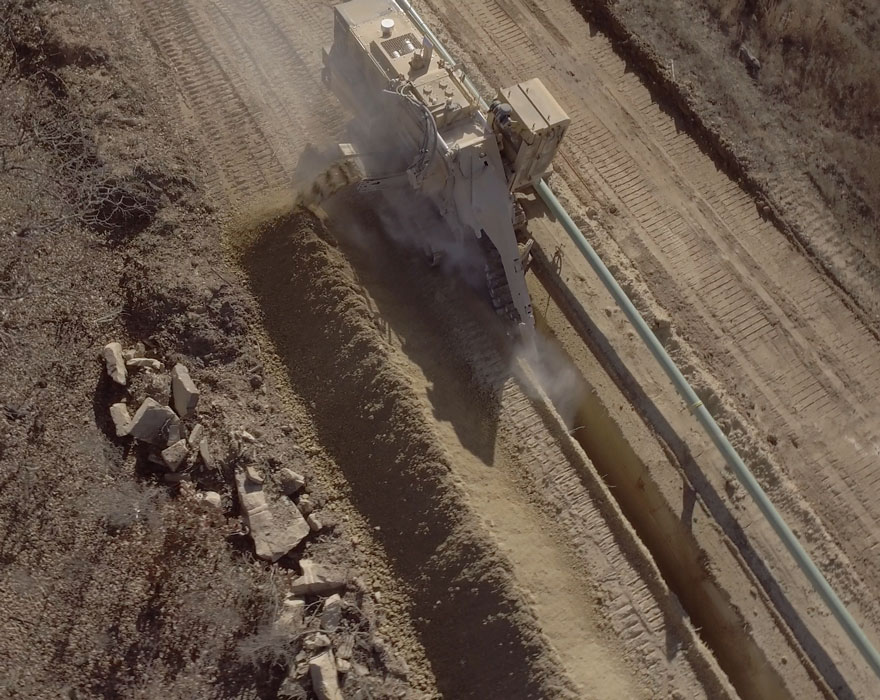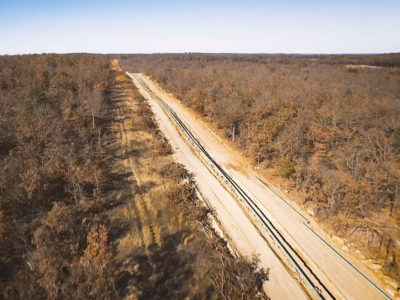Pipeline construction projects across America have flurried in recent years, with miles of natural gas line being added almost daily. A large bulk of new lines is being constructed in the prolific Permian Basin, with midstream energy companies, like Targa Resources Corporation, expanding to support growing demand for natural gas and liquified natural gas (LNG) exports.
One contractor involved with the construction of Targa’s massive Grand Prix Natural Gas Liquids (NGL) Pipeline is Horizon Pipeline & Construction, based in McAlester, Oklahoma. Established in 2015, the young company already employs a team of about 550 people. According to Horizon Pipeline Operational Manager David Baggs, their timing couldn’t have been better. “I’ve been in pipeline for 22 years, and the past few are among the best I can remember,” he said.
Grand Prix Oklahoma extension
Horizon Pipeline crews can be found working throughout Texas, Colorado and Mexico, but a few of the company’s recent projects have been close to home. The Horizon Pipeline team has been instrumental in helping to expand the Grand Prix Pipeline into southern Oklahoma to integrate Targa’s SouthOk and North Texas G&P assets — and connect to a new Hickory Hills processing plant. Over seven months, crews have laid more than 110 miles (177 kilometers) of NGL pipe, including an extremely challenging 30.3-mile (48.8 km) stretch of 10-inch (25.4 cm) steel NGL line near McAlester, Oklahoma — the Hickory Hills job.
Hickory Hill challenge
Sandstone — and lots of it — was in store for the Horizon Pipeline crew on the Hickory Hills stretch of the Grand Prix Pipeline. Baggs estimated around 70 percent of the installation was in rock and rough terrain. “McAlesteris home for us, so we knew how tough the ground conditions were going to be,” he explained. “We decided pretty quickly that using a rock trencher was going to be the most efficient way to handle the bulk of the open trench work.”
Horizon Pipeline typically subcontracts out any trenching or horizontal directional drilling work on its projects. However, the team decided to rent a track trencher and perform all the open-cut work themselves. “There are 20 miles (32.2 km) of open-cut work and 10 miles (16.1 km) of trenchless installs on this job,” Baggs said. “Subbing both would have had a significant impact on our productivity and efficiency. So we decided to look at renting a large trencher.”
After a bit of research, Horizon Pipeline settled on a Vermeer® T855 COMMANDER® 3 track trencher rented from Vermeer Great Plains in Catoosa, Oklahoma. “Given the amount of rock we were working in, a few of our guys were a bit concerned that the T855III was too small for the job, but it ended up having plenty of power and did a nice job cutting through the hard rock.”

The crew used the T855III with an 8-foot (2.4 m) boom to cut a 36-inch (91 cm) wide trench, 5 feet (1.5 m) deep before laying the 10-inch (25.4 cm) steel NGL pipeline. In common ground conditions for the area, they were able to open 1,500-2,500 feet (457-762 m) a day. When working in harder rock, production slowed to between 800-1,200 feet (243.8-365.8 m) a day.
“Given the ground conditions, we were thrilled with the production,” expressed Baggs. “We went through some teeth throughout our rental, but that’s to be expected. Our Vermeer representative, Dusty Warlick, was good about dropping off what we needed when we needed it, which certainly helped reduce maintenance.”
More importantly, Baggs said renting the T855III was the right decision. “There was no way we would have been able to cut a trench using track hoes alone cost-effectively, and for the time we ended up being on the job, using a subcontractor would have been even more cost-prohibitive. Ideally, we’ll end up purchasing a few Vermeer track trenchers as we continue to grow.”
Unexpected delays
While the work went according to plan, the project did take Horizon Pipeline’s team longer than expected because of bad weather — and being needed to complete another stretch of pipeline for Targa. “The fall of 2018 was one of the wettest we’ve had around here,” Baggs said. “It rained several days almost every week we spent on this job. There was a week we got nearly 40 inches (101.6 cm) of rain. It was terrible!”
“We had a semitruck that was completely demolished in the floods, and one of our HDD subcontractors lost a reclaimer,” Baggs continued. “They were set up on the top of a 15-foot (4.6 m) river bank. The river rose so quickly, they couldn’t get the machine moved out of the way in time. I’ve never seen anything like it.”
Heavy rains forced the trencher crew to shut down for several days. However, they operated so efficiently on the days they were able to run, they did manage to make up most of the time lost. “There is no way of knowing what the weather is going to do, so I’m sure glad we decided to rent a rock trencher,” Baggs add. “Without it, we would have been even further behind.”
Horizon Pipeline was awarded another project for the Grand Prix Pipeline Oklahoma extension to do a 50-mile (80.5 km) stretch between Velma and Davis, Oklahoma. “That job had a very tight deadline, so we had to pull a lot of people from the Hickory Hills job over,” said Baggs. “For the most part, we kept the trencher going, but we needed just about everyone else on the other project to keep everything on schedule.”
Crews wrapped up the Hickory Hills job and the 50-mile stretch in about nine months despite setbacks. The team also used the T855III on the 50-mile (80.5 km) project, where it was used to dig another 30,000 feet (9,144 m).
“The Vermeer trencher earned its keep around here. We were sad to give it back,” Baggs explained. “We have a lot more pipeline work coming up in West Texas, and we may need to rent another trencher as we fight with the hard caliche rock in that part of the state.”
This article contains third-party observations, advice or experiences that do not necessarily reflect the opinions of Vermeer Corporation, its affiliates or its dealers. Testimonials and/or endorsements by contractors in specific circumstances may not be representative of normal circumstances experienced by all customers.
Vermeer Corporation reserves the right to make changes in product engineering, design and specifications; add improvements; or discontinue manufacturing or distribution at any time without notice or obligation. Equipment shown is for illustrative purposes only and may display optional or global-region specific features, accessories or components. Please contact your local Vermeer dealer for more information on machine specifications.
Vermeer, the Vermeer logo and COMMANDER are trademarks of Vermeer Manufacturing Company in the U.S. and/or other countries.
© 2019 Vermeer Corporation. All Rights Reserved.
